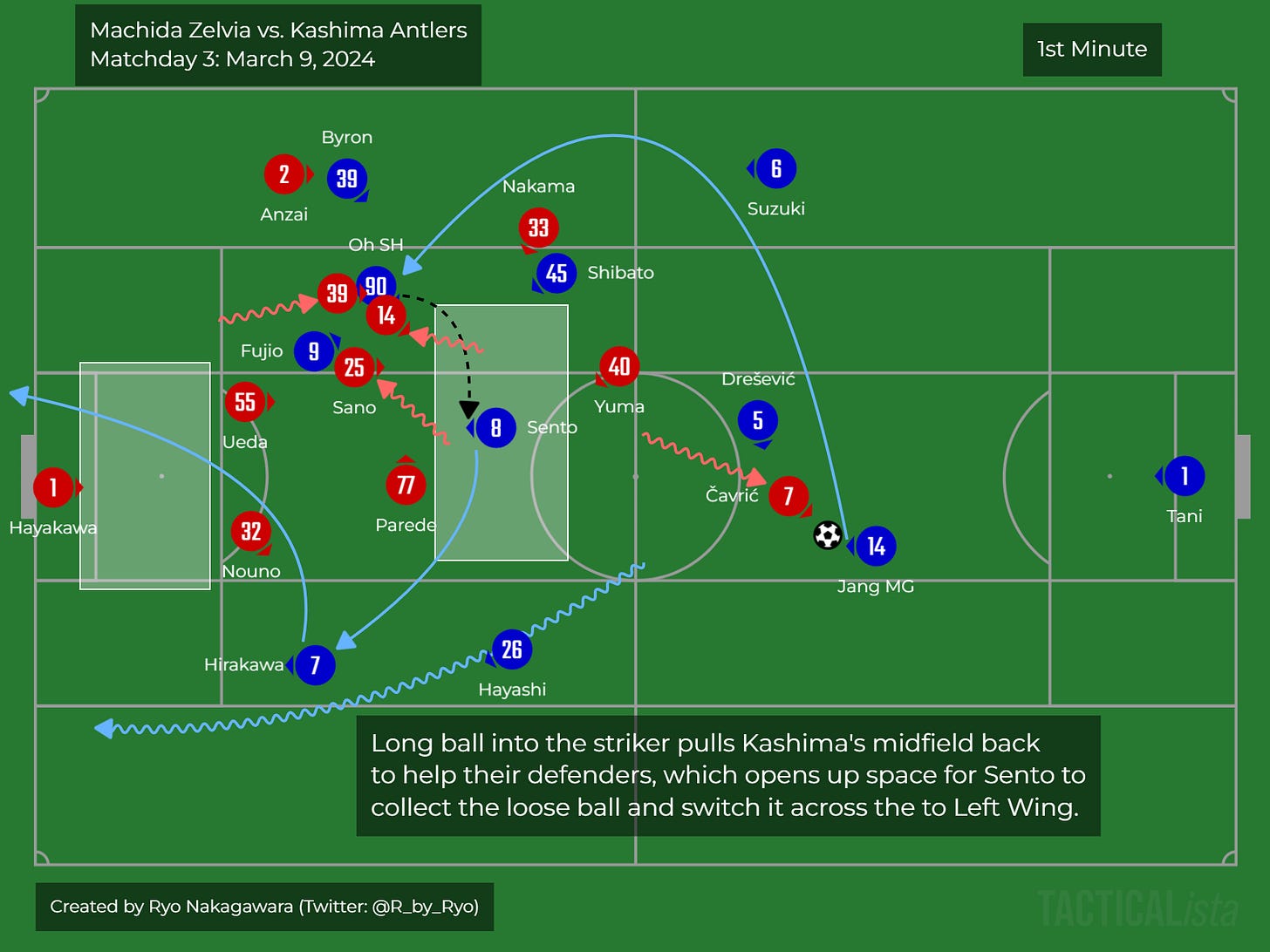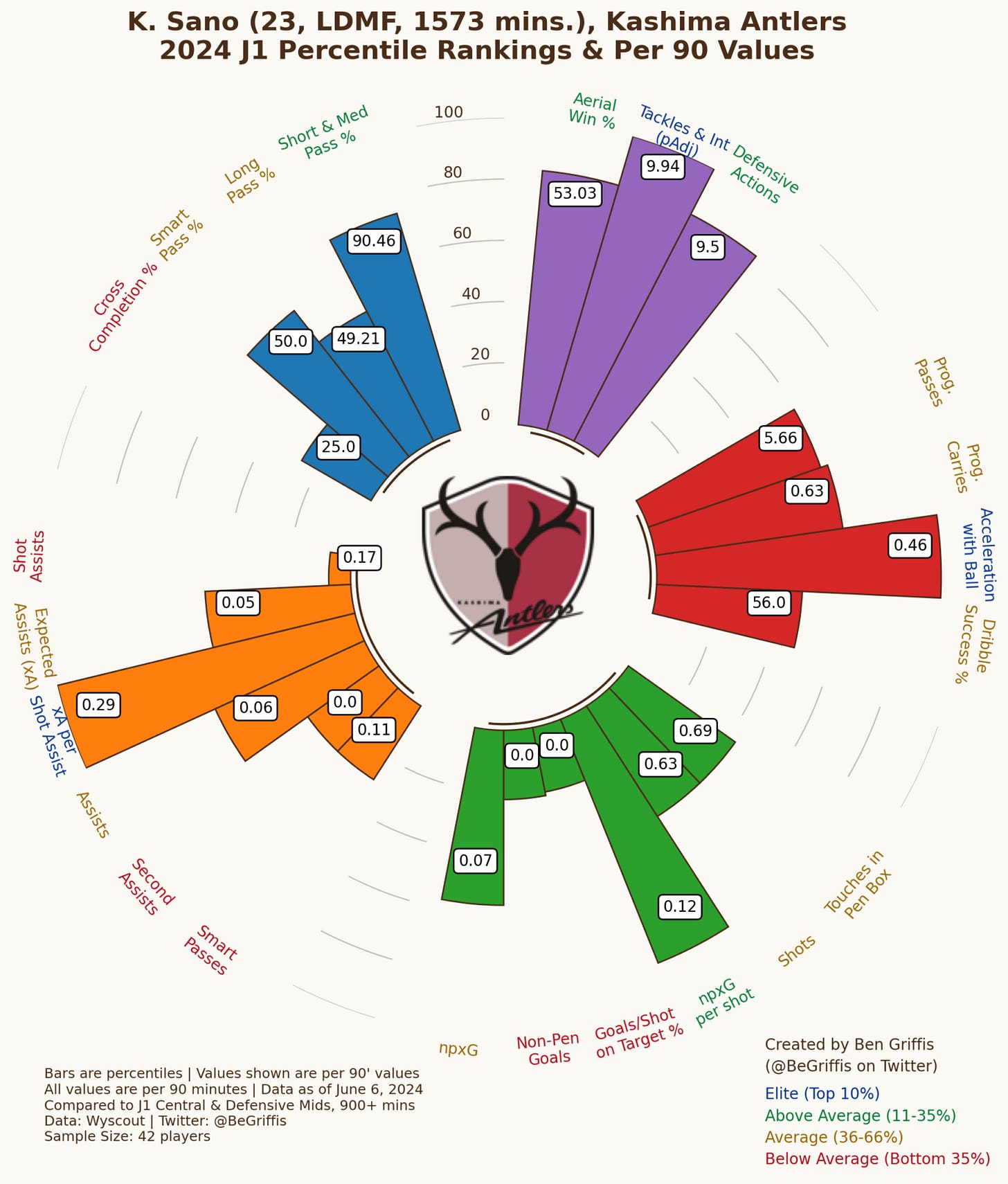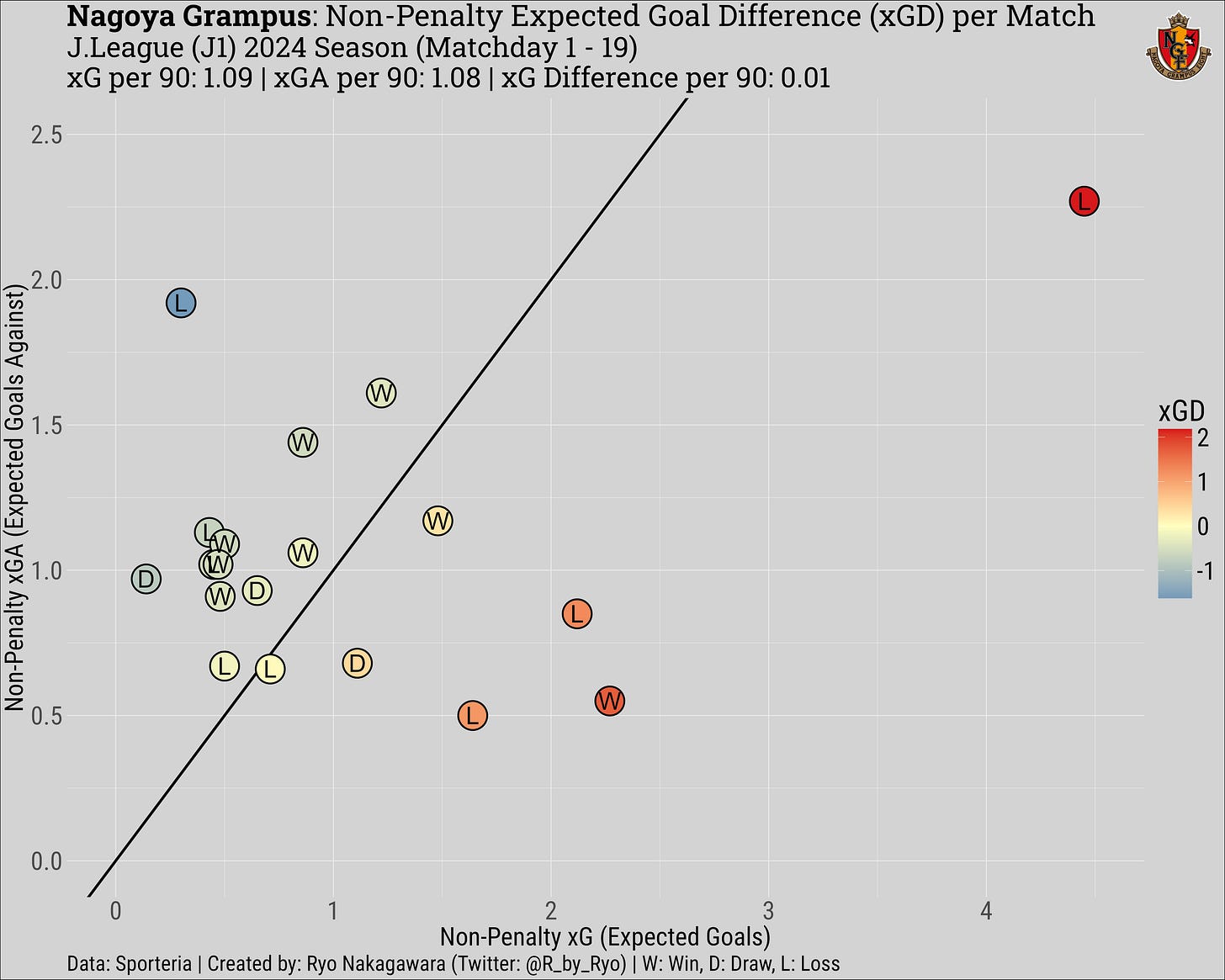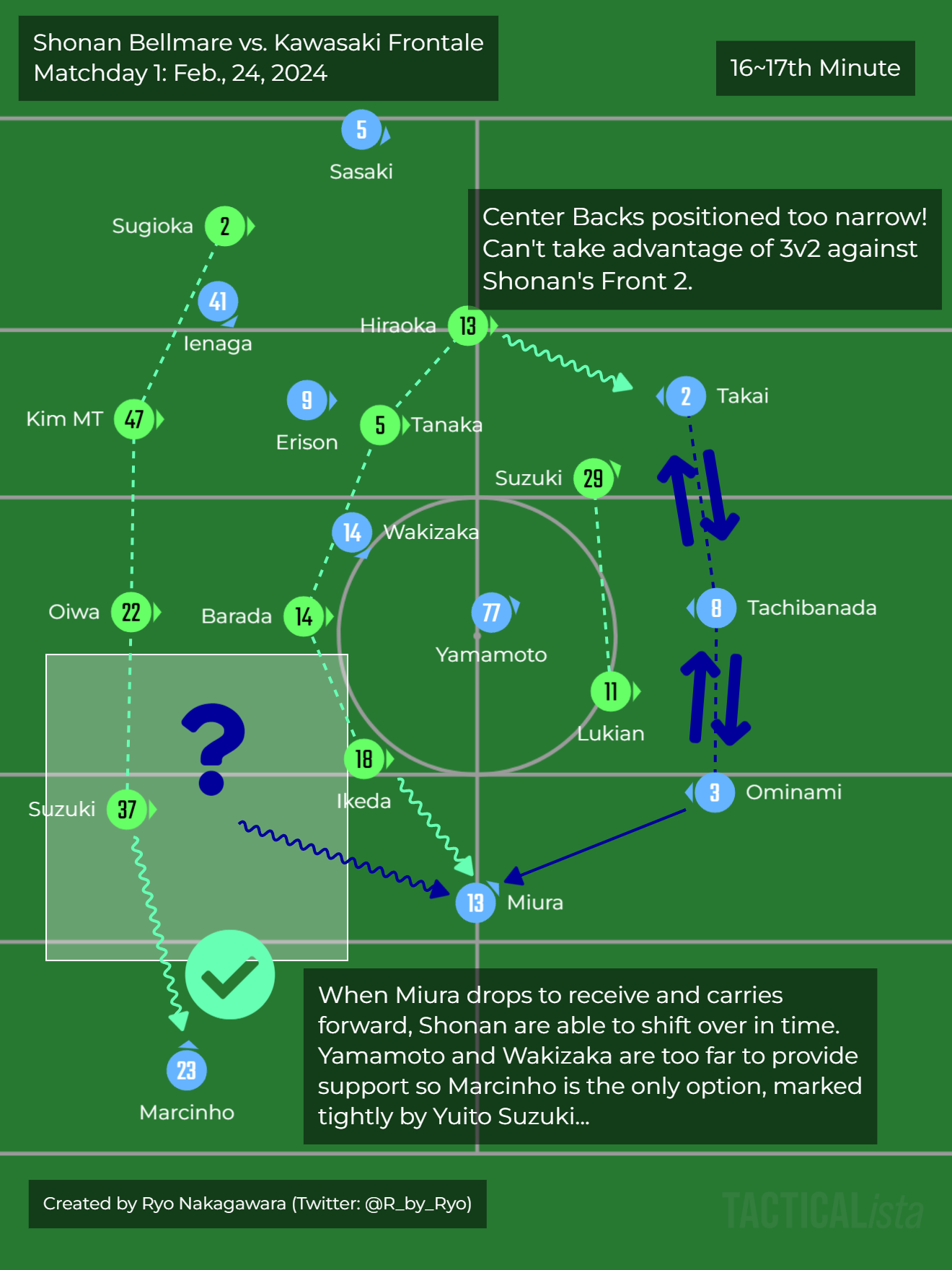J1 2024 Mid-Season Review
Machida Zelvia continue their rapid rise. Consadole Sapporo on the brink...
Hello again, it’s the time of the year for… the J.League Mid-Season Review! For those unfamiliar, I take a detailed look at each and every team with both data and my eyes.
The J1 mid-season reviews going forward will be much shorter as doing the full-length reviews even just once a year takes up a huge amount of time and energy, doing it twice at the same level of effort is simply not worth it:
It doesn’t matter the amount of automation/streamlining I can do on the data side because the tactical side (taking notes, re-watching scenes, creating the diagrams, thinking through every team, etc.) simply dwarfs the amount of time/energy anyways so that’s why I’m cutting back the mid-season review. On the other hand, as you saw in the previous newsletter, the shorter data-focused format will be expanded to J2 and J3 as well!
This review goes up to MATCHDAY 19 only! I won’t mention Wednesday’s Matchday 20 at all here.
This review consists of:
The league table!
A section on every J1 team: Summary overview, tactics, data, players, etc.
A section on the different types of data viz: Explanations and link to the viz for every team!
Some notes, warnings, disclaimers, etc.:
All the data stuff is done with R. The player radars are courtesy of Ben Griffis.
All the tactical stuff is created using Tacticalista.
To keep up to date with all of what’s happening in J1, I made a giant Twitter thread of lots of cool informed people to follow on Twitter for English language/international J.League content. You can find it here!
All of the shots and xG related stuff you see in the viz are non-penalty stats. Exceptions are stuff like the time interval and scoring situations plots. When I mentioned these stats in writing I usually mean non-penalty at the team level but I explicitly write it out at times just to be super clear.
My views come from watching only J1 league matches as most cup games clash with my work schedule and I can’t be bothered to subscribe to yet another streaming service. The things I talk about here are primarily based on the J1 league with occasional references to cup competitions.
Data sources: Transfermarkt, Sporteria, Football-Lab, FBref
Once again, this has taken up a gargantuan amount of time for me to watch/read/code/compile/organize so please like and share it across all of your social media, your IRL (in-real-life) friends, your family, your dog, etc.
Let’s get started!
League Table (After Matchday 19)
The biggest surprise has been Machida Zelvia who lead the table straight after promotion from J2! They simply continued their good form and didn’t falter up to this point. Hot on their tails are Kashima Antlers and Gamba Osaka to round up the top 3 and Asian Champions League spots. Then only six points separate 4th to 10th. On the other side of the table Consadole Sapporo, Kyoto Sanga, and Shonan Bellmare currently make up the relegation zone.
Machida Zelvia (1st, 39 points): 12 W / 3 D / 4 L
Location // Stadium: Machida // Machida GION Stadium
Manager: Go Kuroda
31 Goals (3rd); 16 Conceded (3rd)
Top goal scorer: Shota Fujio (6 goals plus 1 penalty)
Goalkeeper: Kosei Tani
This season’s surprise package has been Machida Zelvia who made big transfer waves during the summer to overhaul their squad up to a J1 level, then proceeded to storm their way up to the top of the table!
Their play-style is fairly straightforward:
Pump long balls to their big strikers (Oh S.H., Duke, etc.).
Win the initial aerial or pick up the 2nd/loose ball (Sento, Shibato).
Spread it wide to their Wide Midfielders or Full Backs bombing up (Hirakawa, Hayashi, etc.).
Cross it into the box (open-play or set-pieces) or long throw-in attempts.
Score… or if not, knock back or collect clearances and start again from Step 1.
Machida’s defense has been very strong with Ibrahim Dresevic and Gen Shoji being largely excellent (you could say they’re the best pairing in the league right now) with Kosei Tani also in good form between-the-sticks to the point that he’s been called back up to the Japan national team. Unlike a lot of teams Machida are good at defending from set-piece and crossing situations too.
Yu Hirakawa and Shota Fujio have been stand-out attackers for Machida and the U-23 Japan team. Oh Se-Hun (whose performances have also led to a call up to the Korean national team) has been able to keep last year’s battering ram, Mitchell Duke, out of the line-up while Erik has slowly come back from his major injury in 2023.
Detractors will point to their rough-house physical style, the time-wasting, and skirting-the-rules antics of both players and coach but nonetheless it is Machida that deservedly sit in firm control of the title race.
All data viz:






Kashima Antlers (2nd, 37 points): 11 W / 4 D / 4 L
Location // Stadium: Kashima // Kashima Soccer Stadium
Manager: Ranko Popović
33 Goals (2nd); 22 Conceded (8th)
Top goal scorer: Yuma Suzuki (6 goals 4 penalties)
Goalkeeper: Tomoki Hayakawa
Long time J.League watchers were bemused by the announcement of Ranko Popović joining Kashima Antlers, including yours truly (for those unfamiliar he doesn’t exactly have a great record in Japan). However, he’s got Kashima near the top of the table where they should belong, given their squad of players. I’ve mentioned this in previous reviews but Kashima have not finished below 5th since 2012! To me, it’s largely been due to the competitive squad that can get results regardless of their manager (Daiki Iwamasa…) but this time around, Popović actually has been a value-add to this squad and as a result they are certainly in the title race.
One big call he has made that has paid dividends is dropping striker Kei Chinen down into the double-pivot. Yes, you heard that right, Kei Chinen is a central midfielder now! At the beginning of the season I was extremely skeptical… but it’s worked due to Chinen’s ability to be physically dominant and win the ball back.
Of course, next to Chinen you have Kaishu Sano who has continued his good form. He is a fantastic ball-winner and a driving force for Kashima in both defensive and attacking transitions. Time will tell if Kashima will dip into the market to deal with Kaishu Sano’s inevitable move to Europe (as of writing he’s going to Mainz), although Popovic could simply play set-piece specialist and rhythm-maker Yuta Higuchi again. Club legend Gaku Shibasaki is also back from injury too.
Another surprise has been the form of Shintaro Nago who somehow has 4 goals and 5 assists! This is more Goals plus Assists he’s contributed in his entire 6 year pro career combined! Among a batch of university-graduate Right Backs to appear in the J.League this season is Kimito Nouno, who with his late runs into the box has been on the end of 5 goals already this season. I think he’s still a liability defensively but a fun player to watch nonetheless. Up front Yuma Suzuki continues to excel while Aleksandar Cavric has also been decent (when he’s not falling asleep defensively like vs. Tokyo Verdy…).
My biggest concern about Kashima is that they’ve run really “hot” in front of goal, scoring their fair share of extremely well-taken goals (rather than consistently creating good-to-great chances) to win close games or to break the deadlock when they’ve looked fairly pedestrian otherwise.
Antlers have also been extremely good from set-pieces so if teams start preparing better than that may also impact Kashima’s ability to nick points in close games as well!
At the other end of the pitch, Center Back Naomichi Ueda has been in fine form alongside Ikuma Sekigawa (an old favorite of mine if you read my old blog posts back in 2021…!) while Tomoki Hayakawa has been a steady, if unspectacular, presence between the sticks and as long as the midfield keep doing their job then I don’t really see any issues here.
Another big problem is the lack of depth in this squad, especially in defense. I mentioned Kashima’s two Center Backs… guess what? Those are pretty much the only two they’ve got! 20 year old Keisuke Tsukui simply isn’t ready and they’ve had to shift Kaishu Sano into the back-line when there have been injuries (Kashima fans I’m sure had flashbacks to when poor Kento Misao had to play as a Center Back full-time a few years ago…). They also don’t really have cover for Nouno and Anzai at Full Back, unless they shift Shintaro Nago or Tomoya Fujii from midfield (well, okay Hidehiro Sugai also exists…). Kashima should count their lucky stars that they haven’t had major injury issues this season! I will also point out that they have a really bad habit of conceding late goals and it again speaks to the lack of depth as Popović doesn’t have options on the bench to tighten things up or re-energize the team.
All-in-all I don’t expect Kashima to win the title as their attacking output doesn’t seem sustainable to get the results they need. However, this is an improvement over the Daiki Iwamasa disaster-classes we’ve seen in the past two years so there’s a potential runway here for actual success!
All data viz:






Gamba Osaka (3rd, 37 points): 11 W / 4 D / 4 L
Location // Stadium: Osaka // Panasonic Stadium
Manager: Dani Poyatos (Spain)
19 Goals (14th); 14 Conceded (1st)
Top goal scorer: Takashi Usami (6 goals plus 2 penalties)
Goalkeeper: Jun Ichimori
Gamba Osaka are back to where they “should” be, near the top of the table and well equipped for a title charge. A big part of Gamba’s resurgence has been the fact that this squad now finally has threatening wingers! With Welton (2 goals and 5 assists) and Ryoya Yamashita (only recently back from a long term injury but making an immediate impact) able to drive at players with speed, they can threaten in-behind from long balls or they can receive to feet to dribble which gives Gamba more options when attacking instead of having to mostly wait for Left Back Keisuke Kurokawa’s overlaps for any width in the final 3rd like in 2023.
Another big factors has been that their defending has stabilized and it has had the knock-on effect of their possession game actually working this season. Shinnosuke Nakatani might be one of the signings of the season in the way he has shored up a horrific back-line in 2023 (which I, and others, went into depth last season). This is despite the fact that Nakatani’s main partner, Genta Miura, has been injured since Matchday 10 and will be out for some time yet. Jun Ichimori has also been very good in goal after showing his worth at Marinos on-loan last season.
It’s not just about the individuals but as a team they are able to defend quite well in their 4-4-1-1 shape out-of-possession with the front-line leading the press or covering the opponent’s midfield pivots in the build-up. Gamba Osaka are just generally so much more organized whether defending deeper or higher up the pitch and that allows them to win the ball and settle possession in a better structure, more often.
On the other hand, they are extremely reliant on talisman Takashi Usami scoring killer goals, he’s scored 7 goals from just 4.76 xG so far this season according to Football-Lab (plus 3 assists). Usami has been one of the players of the season so far, the team actually functioning as a whole has given him the time/space to deal damage to the opponent. He looks nothing like the version we saw in 2023! Isa Sakamoto has gained plaudits for a lot of the link-up play and driving Gamba forward on the attack but he hasn’t quite been a threat inside the box despite his 3 goals making him the 2nd best goal scorer in the team.
Indeed, overall Gamba are tied 4th worst in the league for goals scored, they have the same amount of goals as notoriously goal-shy Avispa Fukuoka which is quite indicative of their woes this season! If they can use their possession play to create more dangerous chances consistently, then they can start getting other players onto the score sheet to really push for the J1 title in the 2nd half of the season.
All data viz:

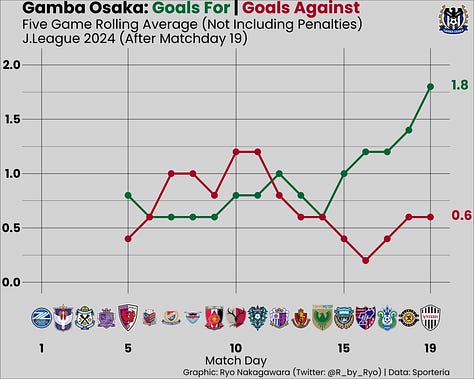






Vissel Kobe (4th, 33 points): 10 W / 3 D / 6 L
Location // Stadium: Kobe // Noevir Stadium
Manager: Takayuki Yoshida
27 Goals (9th); 15 Conceded (2nd)
Top goal scorer: Taisei Miyashiro (7 goals)
Goalkeeper: Daiya Maekawa
Results-wise Vissel Kobe have been a bit unlucky this season in my opinion, yet they are still well within shot of a consecutive J1 title as they sit in 4th. Nothing has changed in terms of playing style as they continue to be physically battling, run hard in the press, and make surging runs forward from deep.
Yuya Osako is having a slight down-year with only 4 goals and 3 assists so far but he’s still the most important player on this team, doing his usually hold-up play and creating lots and lots of chances. I would still have him finishing in the double digits (well for goals plus assists, at the very least) by the end of the year.
To pick up the slack is not only his usual partner-in-crime Yoshinori Muto (5 goals and 2 assists) but the new signing, Taisei Miyashiro! After being sent out on many loans and then misused by Tohru Oniki on his return to Kawasaki Frontale last season, Miyashiro had enough and moved to Kobe in the off-season. He’s had a stellar season so far with a team-leading 7 goals and 1 assist. It’s a good bit of succession planning as both Muto and Osako are well over 30 years old at this point.

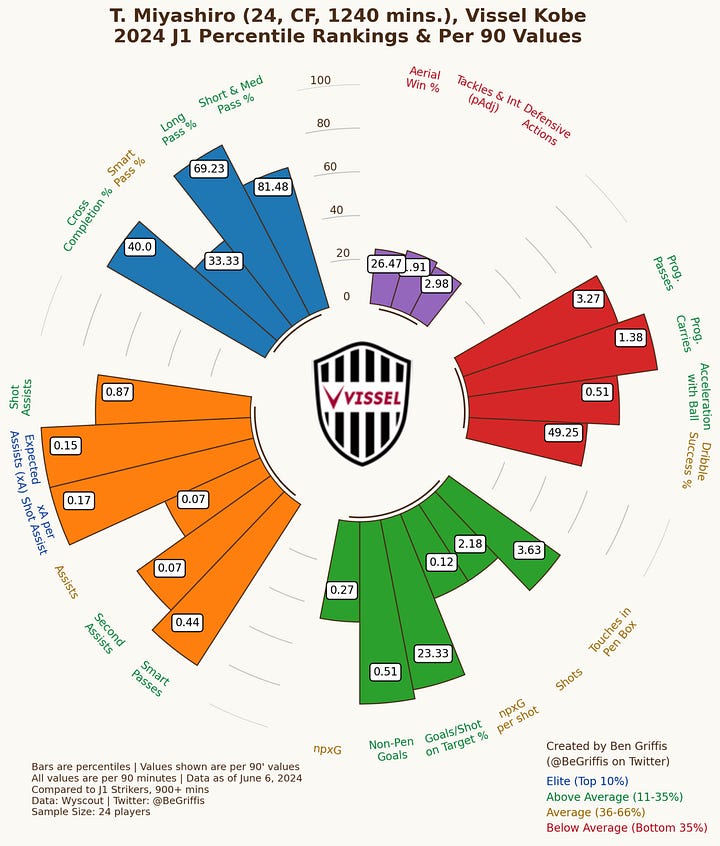
Readers might also be quite amused to hear that Vissel Kobe this season are actually leading the league in non-penalty xG and in the top 3 for a few other attacking metrics so far this season! Interestingly enough this is despite the fact that nearly 50% of their goals have come from set-piece situations.
I’m a bit surprised that Yosuke Ideguchi hasn’t nearly started as many games, especially ahead of Takahiro Ogihara, who has really cemented his place in the side after Mitsuki Saito’s major injury last year. Ideguchi was very good for Avispa on his return to Japanese football in 2023 and his energetic ball winning was/is a perfect fit for Kobe. In defense, Matheus Thuler remains one of the best Center Backs in the league while the usual Full Backs in Ryo Hatsuse and Gotoku Sakai work hard up-and-down the flanks. Kobe have conceded the 2nd least xGA (15.9), 4th least shots against, and league-best xGA per shot which highlights their continued solidity in defense that was a hallmark of their title-winning season last year.
The big question for this team is: as the Asian Champions League starts up in autumn, will Kobe be able to maintain their title charge? Vissel Kobe had filled out their squad with the likes of Ideguchi and Kuwasaki in midfield while Ryuho Kikuchi has also returned from a long injury lay-off. Nevertheless, the core of the squad are all still the over 30s contingent of ex-Japan National team stars…
All data viz:







Sanfrecce Hiroshima (5th, 32 points): 8 W / 8 D / 3 L
Location // Stadium: Hiroshima // Edion Peace Wing Stadium
Manager: Michael Skibbe (Germany)
35 Goals (1st); 19 Conceded (5th)
Top goal scorer: Yuki Ohashi (6 goals plus 2 penalties)
Goalkeeper: Keisuke Osako
Sanfrecce continue their awful shot conversion for the third straight season under Michael Skibbe. It’s long become a meme at this point. As a result, although they didn’t lose their first eleven games of the season… a whole seven of those games were draws!
The problem with them is that while Sanfrecce rack up the shots and the xG on paper, it’s more of a result of the absolute volume of shots they are willing to take rather than consistently making medium-to-high quality shots. I’ve… already explained this exact phenomenon in previous season reviews.
The fact that most of their goals actually come from set-pieces is honestly quite telling of their actual inability to score from open-play despite their stats…
I think everybody knows how Sanfrecce play at this point. High pressing, very vertical play, but unfortunately these speedy attacking sequences all-too-often end up with speculative crosses, sometimes by strikers who drifted out wide that you wish were actually in the box on the end of said crosses…
Their defense, at least their Back 3, remain close to the strongest defensive unit in this league. Despite my worries over the past few seasons, Sho Sasaki and Tsukasa Shiotani are still going strong at their ages. Hayato Araki’s medium-term injury saw Shuto Nakano step inside from Wing Back while guys like Shunki Higashi has done similar in the past so plans for the near-future certainly exist even without new arrivals. One big transfer success has been Yuki Ohashi who has had a barn-storming season so far with 8 goals and 3 assists while Naoto Arai has also ingratiated himself quickly with the Sanfrecce supporters with 4 goals in limited minutes.
However, now they are losing a very important midfield fulcrum in Takumu Kawamura (see my analysis of him on his transfer to Red Bull Salzburg here) so Sanfrecce Hiroshima have a huge summer ahead as they aim to push up the table and navigate the inaugural Asian Champions League 2.
All data viz:


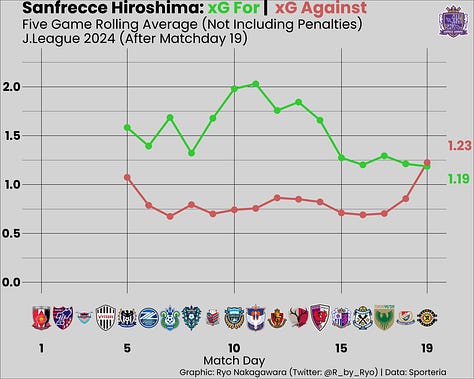


FC Tokyo (6th, 30 points): 8 W / 6 D / 5 L
Location // Stadium: Tokyo // Ajinomoto Stadium
Manager: Peter Cklamovski (Australia)
29 Goals (5th); 26 Conceded (11th)
Top goal scorer: Ryotaro Araki (6 goals)
Goalkeeper: Taishi Nozawa
FC Tokyo in (upper?) mid-table, as they usually are… There have been elements of a good team brewing somewhere in there especially with the Ryotaro Araki plus Kuryu Matsuki “double-false-nine” system that manager Peter Cklamovski cooked up during pre-season (or a fever-dream). However, FC Tokyo have now only won twice in their past seven matches as any notion of a potential Champions League place is once again looking far away. NOTE: I typed all this right before Matchday 20 where FC Tokyo squeaked by Consadole Sapporo to rise to 6th and only 7 points behind 1st place…
The team is a weird mix of trying to play a more possession-based style and yet looking far more dangerous in transition, especially in the chaotic last ten-or-so minutes of games. Tokyo look far more comfortable playing out the back compared to previous years which is nice… but they don’t actually seem to progress the ball much at all and Tokyo certainly don’t take enough shots (4th least in the league) or even quality ones (tied 9th best xG per shot). More damningly, FC Tokyo are 16th in the league in terms of reaching the final 30 meters to goal and 17th for penalty box entries…
The attack has been extremely reliant on Ryotaro Araki scoring magical goals (6 goals from just 1.77 xG!) and is usually dependent on creating isolations on the wing for Kota Tawaratsumida to take players on the dribble 1v1. Tawaratsumida drives forward with the ball quite well, can take people on, but his final ball remains inconsistent and takes a lot of shots from poor positions on average. Of course, the young winger isn’t helped by the fact that Tokyo don’t seem to have much of a plan after getting into the final 3rd from their build-up play.
On the defensive side of things, I won’t even go into the Center Back problem and the lack of turn-over here as I’ve ranted about this in just about four-or-five previous editions of this review. Kanta Doi, a teenager, has looked the best one of the bunch which is great because he’s a breath of fresh air but also speaks to my frustrations in this regard… oh and he’s also been injured for the past two months anyway. The out-of-possession shifts into a 4-4-2 but the pressing is uncoordinated and the players looked confused on when/where to push up behind the forward players.
Curiously, while Tokyo’s defense gives up the 5th worst amount of shots against, they have been able to keep the quality of those shots down on average (3rd best in the league in terms of xGA per shot).
This is yet another FC Tokyo team that look very confused as to what they really want to be. I really can’t see this team finishing anywhere else than mid-table again unless things magically improve in the second half of the season. By this I really mean that our performances start actually catching up to some of our out-of-nowhere good results. Or you know, the ball might just keep bouncing Tokyo’s way and they’ll somehow be in the fight for the Champions League place in the winter…!
All data viz:








Cerezo Osaka (7th, 29 points): 7 W / 8 D / 4 L
Location // Stadium: Osaka // Yanmar Stadium
Manager: Akio Kogiku
26 Goals (10th); 21 Conceded (7th)
Top goal scorer: Leo Ceara (10 goals plus 4 penalties)
Goalkeeper: Kim J.H.
Cerezo were another team that started the season quite well as they didn’t lose a single game until Matchday 9, then they started sputtering… Now they are in 7th, 10 points behind 1st Place… Looking at the stats, it felt like that was coming as their numbers really weren’t lining up with their results in the early part of the season.
Indeed if you look at their spread of stats like shots for/against, xG for/against, etc. Cerezo are usually somewhere right in the middle of the pack which don’t make sense for a team that would be in the title fight, so their current position makes more sense.
Much has been made about their 3-2 build-up and I’ve talked about it quite a bit on Twitter earlier in the season. The transfer and subsequent conversion of Shunta Tanaka into a central midfielder has been the crux of this tactical change alongside another winter acquisition, Kyohei Noborizato, inverting from the Left Full Back position into midfield next to Tanaka.
Of course, we can’t forget the contributions of Seiya Maikuma, who has now transferred to AZ Alkmaar in the past week (I wrote a thread on him following the announcement, here). Maikuma is an excellent passer across different ranges, can carry the ball forward, and off-the-ball makes smart runs into the half-spaces or wide areas. Although he is not a huge threat in the final 3rd, Maikuma has been one of the best players at facilitating teams to get into attacking positions from deep.
Further forward Leo Ceara is scoring goals, which has been a big pain point for this Cerezo team in the past few seasons but unfortunately… no one else is following his example with the 2nd highest goal scorer on the team being Shunta Tanaka on 2 (two) goals… Detractors of this team can also point to the fact that despite Cerezo’s fancy build-up patterns and possession-play, nearly half of the goal haul has not come from open-play this season (penalties, direct set-pieces, indirect set-pieces)!
This team still feels weird to me and I can’t really imagine they’ll finish any higher than where they are now. After three full seasons of Akio Kogiku Cerezo Osaka have… not really progressed to consistent title-challengers (or even Champions League place contenders) despite periodical bursts of good form here-or-there!
All data viz:






Avispa Fukuoka (8th, 29 points): 7 W / 8 D / 4 L
Location // Stadium: Fukuoka // Best Denki Stadium
Manager: Shigetoshi Hasebe
19 Goals (17th); 17 Conceded (4th)
Top goal scorer: Shahab Zahedi (6 goals)
Goalkeeper: Masaaki Murakami / Takumi Nagaishi
Last season was a huge accomplishment for Avispa Fukuoka led by the wily old general, Shigetoshi Hasebe as they finished in 7th (their highest ever league finish) and won their first ever trophy in the form of the 2023 League Cup! This season, things have been largely the same. Steady and unspectacular but grinding out some wins in the past month after a worrying patch of form where they only won two games in the first eleven games of the season.
Despite the departure of talismanic striker Yuya Yamagishi to Nagoya Grampus, Avispa hit the jackpot with his replacement, the Iranian striker Shahab Zahedi who has 6 goals and 2 assists so far. Supporting him is the silky dribbler Kazuya Konno with 4 goals and 1 assist, which is already quite close to his career-best of 5 goals and 4 assists from last year! One thing that should absolutely be noted is that both Konno and Zahedi have mostly been scoring worldies (including a behind-the-half-line super lob goal by Zahedi) so Avispa are certainly riding their luck right now in terms of shot conversion/variance.
You could say they need improve but this is also simply how they have always performed since their return to J1 a few years ago… Avispa usually make up for their lacklustre attack with their miserly defense. Fukuoka so far this season have been fairly decent in terms of shots against and xGA (around middle of the league for both metrics). Hasebe likes to keep the amount of shots down for both his own team and the opponent.
In the midfield engine room, Avispa still have Mr. Reliable in Hiroyuki Mae while Daiki Matsuoka has returned from his very odd and ill-advised loan spell in Serie B (Brazil) to rekindle his career in competition with Masato Shigemi.
Douglas Grolli continues to be a ferocious opponent for any J1 striker while this season it looks like Masaaki Murakami (11 starts) is winning this year’s goalkeeping musical chairs contest ahead of Takumi Nagaishi (7 starts).
I’m really not worried about Avispa getting dragged into the relegation fight this season, they are a solid mid-table fixture in J1 now (while of course, they can still hit a rough patch like earlier in the season). More importantly, Avispa Fukuoka are going to really want to figure out how to get more fans to their stadium considering the population size of their city…!
All data viz:


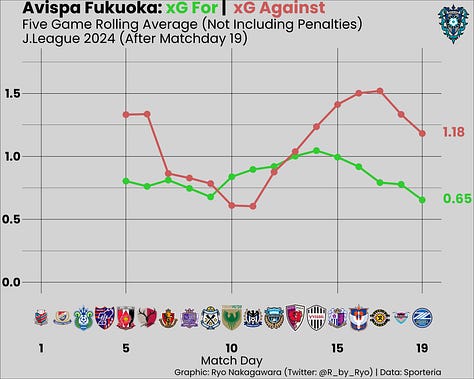





Nagoya Grampus (9th, 27 points): 8 W / 3 D / 8 L
Location // Stadium: Nagoya // Toyota Stadium
Manager: Kenta Hasegawa
21 Goals (16th); 20 Conceded (tied 6th)
Top goal scorer: Kensuke Nagai (4 goals)
Goalkeeper: Mitch Langerak
Nagoya had an extremely poor start after three straight losses to begin the season. Things improved somewhat and they now sit in mid-table. Nagoya lost key defensive pieces in Haruya Fujii (KV Kortrijk in Belgium) and Shinnosuke Nakatani (Gamba Osaka) and to replace them they brought in Mikuni and Ha Chang-Rae. While I think Nagoya have looked poor defensively, it’s weird that they’ve actually only conceded 20 goals (tied 6th best in the league) and 33% of those from set-pieces…
So really, it’s their attack that has really been bringing them down with veteran Kensuke Nagai (at 35 years old) somehow being the top scorer on this team with 4 goals as new signings in Patric and Yuya Yamagishi have struggled. Nagoya have of course not been helped by Kasper Junker’s persistent injury troubles this season.
At the center of every attack has been Tsukasa Morishima who has looked like single-handedly carrying Nagoya’s attack this season. I feel as though he hasn’t got a load of goals/assists this season because he’s just too busy doing everything else on this team. In terms of positives… well Ken Masui looks fun as a dribbler I guess? We are now into Year 3 of Kenta Hasegawa at the helm, things still don’t look right at all. I think this team needs a whole reset as I really don’t see things improving in the 2nd half of the season.
Fans should be worried considering the team is full of 30 plus year olds that aren’t going to be worth much when the re-build inevitably starts…
All data viz:





Tokyo Verdy (10th, 27 points): 6 W / 9 D / 4 L
Location // Stadium: Ajinomoto Stadium
Manager: Hiroshi Jofuku
28 Goals (7th); 30 Conceded (17th)
Top goal scorer: Yudai Kimura (7 goals plus 2 penalties)
Goalkeeper: Matheus Vidotto
Tokyo Verdy have returned to J1 for the first time since the 2008 season and after a pretty woeful (if unlucky) start, the Green half of Tokyo are sitting in mid-table to the relief of their fans. I wrote a thread on Verdy a couple months back and it still largely remains relevant now. Their narrow 4-4-2 out-of-possession shape with the high/mid press has caused a decent amount of trouble to the opposition but the fact remains that they continuously run out of gas in the 2nd Half of games. They also aren’t very flexible in their approach when opponents adapt nor do they have the depth to turn games around with substitutions (despite some poor attempts at a 3-5-2 in recent weeks). Their squad is also extremely thin in J1 level quality outside of their best starting XI so the occasional absences of Koki Morita and Hiroto Taniguchi have hurt them quite a bit this season too.
In attack, their in-possession game is very reliant on Koki Morita or Tomoya Miki shifting across different lines and connecting teammates together. Morita is the captain and heart-beat of this team, he puts in a lot of defensive work in too. Further forward the speed, power, and clinical finishing of Itsuki Someno (4 goals plus 2 penalties), Yudai Kimura (7 goals plus 2 penalties), and Fuki Yamada (3 goals) contribute heavily in very direct attacks.
Considering the amount of points Verdy have banked at this stage in the season I have a feeling they’ll be safe this season especially considering the form of a few other clubs I’ll be talking about further down this review. Further opportunities for a real intense Tokyo Derby should be fun for fans and in general good for football in the capital city (please somebody build a proper football stadium in downtown Tokyo).
All data viz:



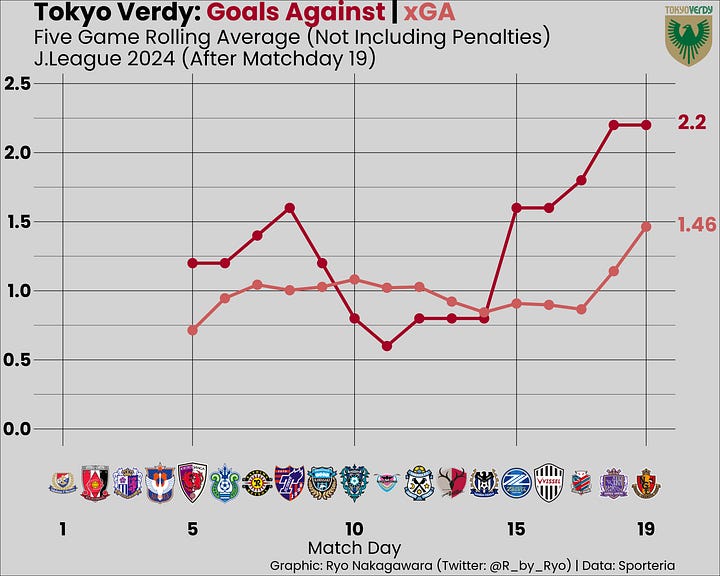



Urawa Reds (11th, 26 points): 7 W / 5 D / 7 L
Location // Stadium: Urawa // Saitama Stadium
Manager: Per-Mathias Høgmo (Norway)
30 Goals (4th); 25 Conceded (12th)
Top goal scorer: Thiago Santana (4 goals plus 3 penalties)
Goalkeeper: Shusaku Nishikawa
Urawa Reds disappointingly sit in mid-table. Per-Mathias Høgmo is now the third manager in as many seasons. While all three managers have similar possession-to-attack minded values that Urawa look for, the actual implementation have been quite different so it’s been another season of transition for the Reds. On top of this, the form of their best players like Atsuki Ito and Alex Scholz (among others) seem to have suffered considerably due to their extraordinary long 2023 season (Asian Champions League and then the Club World Cup in December). Indeed, Alex Scholz missed his first league game since 2022 due to an injury sustained on Matchday 3.
In terms of positives, Samuel Gustafson has been excellent, but I also feel as though Urawa are very reliant on him getting the ball in the build-up to have a chance of progressing forward.
Thiago Santana seems to be solving the long-standing issue of striker at Urawa but one also needs to be careful considering that 3 of his 7 goals have come from the penalty spot this season. Nonetheless, he should continue to score far more goals compared to his predecessors, provided Urawa can keep him amply supplied in the box. Naoki Maeda has looked bright for his new club after switching from Nagoya Grampus in the winter as his dribbling provide Urawa with an outlet on the wing. I was a bit mystified about this transfer as Maeda looked really off-the-pace last season following his return from a injury-ridden spell in Europe. However, he has looked very good this season and I guess he just needed a full pre-season to reset and get to full fitness.
Urawa under previous manager Maciej Skorza were one of the most defensively solid units across the J.League (if not all of Asia), but things seem to have fallen apart as Urawa have already conceded 25 goals this campaign, only two fewer than the total from the entire 2023 season! Ryoma Watanabe has been converted to Left Back for most of this season but I can’t really blame him individually as the problems are more systemic. As can be seen below, the goals conceded have come from a fairly even spread of different situations.
Given their struggles a bit of squad re-shuffling may be necessary. There are lots of transfer market rumors happening as I write this section. Ken Iwao has returned to Tokushima Vortis on the day I’m releaseing this newsletter. Alex Scholz of all players might be on the way out as well while veteran Hiroki Sakai has officially been reported to be leaving (to the Middle East and New Zealand, respectively). Fortunately for Urawa, at Center Back they had already bought back-ups in Yota Sato (analysis here) and Rihito Inoue (analysis here) during the winter for this kind of situation anyway. Sakai might not be missed as much considering he’s been injured often and Hirokazu Ishihara has replaced him in the pecking order at Right Back (still surprising to see Sakai go though). Just today, Rio Nitta has joined the club while there are rumors surrounding Shion Homma returning from a failed spell in Europe as well.
Urawa have a pretty full squad already so time will tell how playing minutes are managed as the Reds figure out a way to push higher up the table.
All data viz:






Yokohama F. Marinos (12th): 7 W / 5 D / 6 L
Location // Stadium: Yokohama // Nissan Stadium
Manager: Harry Kewell (Australia)
29 Goals (6th); 26 Conceded (tied 9th)
Top goal scorer: Anderson Lopes (9 goals plus 3 penalties)
Goalkeeper: William Popp
It’s been a rough 2024 for new Manager Harry Kewell as despite progression to Marinos’ first ever Champions League final, it all ended in tears as they were trounced 5-1 in the 2nd Leg by Al-Ain. Meanwhile their league form has been very inconsistent and even when they win, Marinos look very unconvincing.
Kewell has continued his (multiple) Australian predecessors in playing a possession-based style. When it works well, Marinos can progress quickly into the final 3rd with pace and take advantage of the fantastic 1v1 dribbling ability of Elber and Yan Mateus but all too often things break down in the middle of the pitch or the defenders or the goalkeeper are pressured into mistakes.
Marinos are extremely reliant on Anderson Lopes to score goals as his 9 goals plus 2 penalties lead the team by a large margin. Perhaps Kento Shiogai can continue to make good on his cameo appearances to earn more regular starts when possible, especially after a fantastic Maurice Revello tournament for the Japan U-19s where he finished as the tournament’s top goal scorer!
The defending is pretty woeful having conceded the 9th most goals from the 6th worst xGA in the league and hemorrhage shots on their goal (2nd worst in the league for shots against). About the only positive things you can saw about Marinos’ defense is that they have actually been somewhat decent at preventing quality shots on their goal on average (4th best in the league) and they do have the excuse that their defense has been decimated by various injuries. William Popp has looked awful and it’s ironic how Jun Ichimori is looked back upon fondly now as he continues his good form for Gamba Osaka, despite him being on the end of lots of complaints in 2023.
Marinos are especially vulnerable on set-pieces but in open-play they also do not have the players to play a high-line. The individual quality of Marinos defenders have gone down considerably since the days of Thiago Martins, Tomoki Iwata, and (a fully fit) Shinnosuke Hatanaka in my opinion.
It should be noted that half (or more) of their league wins (Verdy, Kyoto, Kobe, and Sanfrecce) have all come from opponents conceding a penalty or a red card… Things are not looking good at Marinos and Kewell is going to be on thin ice especially if they don’t make up the difference with their game in hand. Of course, due to the nature of the J.League they are “only” nine points behind 3rd with a game in hand…
All data viz:








Kashiwa Reysol (13th, 22 points): 5 W / 7 D / 7 L
Location // Stadium: Kashiwa // Sankyo Frontier Kashiwa Stadium, “Hitachidai”
Manager: Masami Ihara
18 Goals (18th); 26 Conceded (9th)
Top goal scorer: Kosuke Kinoshita (6 goals)
Goalkeeper: Kenta Matsumoto
Kashiwa Reysol find themselves in mid-table which isn’t bad considering their awful 2023 but… given some of their stats I think they actually should be disappointed that they aren’t higher up the league standings. The main reason is that they have both been very unlucky and extremely profligate in front of goal. Reysol have vastly under-performed their xG and well, that’s what happens when you consistently miss penalties and other big chances.
Manager Masami Ihara has continued to set Reysol up well out-of-possession in their tight 4-4-2 mid-block that can also push up higher to press and frustrate opponents. However, one defensive aspect they’ll need to improve upon is set-piece defending which is how they have conceded a whopping 42.3% of their goals…
Despite their chance creation and overall decent xG numbers… the attack is heavily reliant on Matheus Savio performing some magic all by himself, especially in transition moments with only a little support from the likes of Hiroki Sekine and Mao Hosoya. To note, Mao Hosoya has had an absolutely awful season in front of goal so far, with only 1 goal from 4.35 xG (source: Fotmob)! Keep in mind this also includes a missed penalty but on the other hand you could say that he’s been a bit unlucky as his xGOT is actually 5.32 (Fotmob) showing Hosoya has also been kept out (potentially) by some good goalkeeping. Unfortunately, manager Masami Ihara can’t exactly sub himself on to kick the ball into the net for his players, especially since he was a defender in his playing days!
One interesting caveat I will give for Reysol’s good stats is… game-state! Reysol seem to give up goals early on in games which means they are disproportionately incentivized to attack and “throw the kitchen sink” as the game goes on, wracking up their xG and shot numbers compared to their opponent who might be happy to sit back a bit.
Honestly, this team still isn’t great but they shouldn’t be in any relegation struggle like last season. It is extremely reliant on Matheus Savio keeping fit while Mao Hosoya may leave for Europe at any time (he’s already rebuffed attempts in the past year) so they can’t sit on their laurels right now. A positive has been that Kosuke Kinoshita has found his shooting boots despite limited minutes, while Takuya Shimamura has been very good on the opposite wing of Savio with 3 goals and 3 assists so far.
All data viz:






Kawasaki Frontale (14th): 5 W / 6 D / 8 L
Location // Stadium: Kawasaki // Todoroki Athletics Stadium
Manager: Tohru Oniki
27 Goals (tied 8th); 28 Conceded (13th)
Top goal scorer: Shin Yamada (5 goals plus 1 penalty)
Goalkeeper: Jung S.R.
Kawasaki Frontale continue their crisis as they sit in 14th, only 6 points away from the relegation zone! Manager Tohru Oniki’s attempts to revamp the team that were champions only three seasons ago has not gone at all to plan.
The attempts to turnover the squad haven’t really done much to stop the rot. While Erison looked bright and looked like the successor to Leandro Damiao early on… his form fizzled out after returning from injury (and he’s also injured again right now). Neither of the other two Brazilian signings (Ze Ricardo and Patrick Verhon) have apparently panned out with neither getting any significant minutes as of yet. I have liked what little of I’ve seen of Ze Ricardo though…
Bafetimbi Gomis has had a rough start but finally scored his first J.League goals since his arrival last summer, even though it was a hat-trick against an equally poor Consadole Sapporo team so the jury is still out on him yet. Yuki Yamamoto as the club’s marquee signing from Gamba Osaka has not really worked out either which has been very disappointing considering how good he was last season.
The veteran attackers Yasuto Wakisaka and Akihiro Ienaga have actually been quite good individually but the team really looks out of sorts as a unit. If I’m really grasping at some positives then I think it’s nice that the goals are spread out across quite a few players so their not so reliant on one guy… Oh, and I do quite like Shin Yamada too and surprisingly he is Frontale’s top goal scorer with 5 goals and 1 penalty. Yamada is really strong on the ball and loves bursting past defenders with his pace and pure ferocious tenacity.
When I’ve watched Frontale this season, there are sequences or even a decent chunk of matches where they do look like that “classic” Frontale with slick passing and field tilt but… the real big issue has been Frontale’s defense. Oniki seems committed to continuously playing midfielders at Full Back and/or oddly shuffling of players in a variety of formations. As a result nothing looks cohesive anymore and especially the build-up play looks terrible. Jesiel looks well past it now while Takumi Ominami has never actually been very good in my opinion and I don’t understand why they bought him. Teenage Center Back Kota Takai has really struggled without a proper structure around him despite his promise and the decent performances he showed in Japan’s U-23 Asian Cup victory a few months ago.
This has all made Frontale’s defense one of the worst in the league in my opinion, despite only conceding 28 goals. When you consider that Frontale have recorded the worst xGA per shot in the league, 7th most shots conceded, 2nd worst xGA per 90, things could actually be even worse defensively if their opponents were either slightly better or lucky!
I don’t think it’s a particularly controversial opinion that Tohru Oniki should’ve been fired after the end of a shambolic 2023 season (even if it did end in a trophy in the form of the Emperor’s Cup). There’s a good group of players in this squad somewhere but while Oniki has tried to do a lot of different things, it’s simply not been enough.
All data viz:


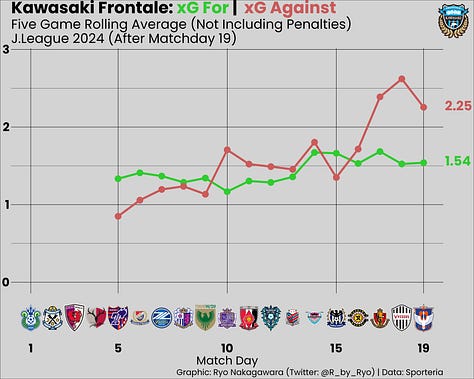
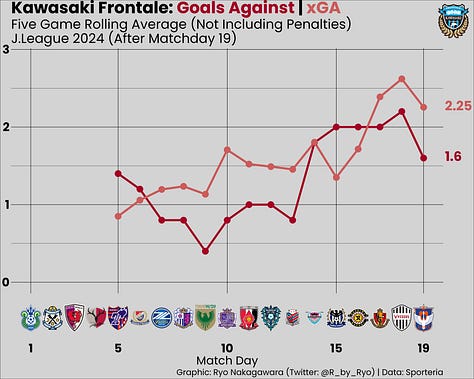


Albirex Niigata (15th): 5 W / 6 D / 8 L
Location // Stadium: Niigata // Denka Big Swan Stadium
Manager: Rikizo Matsuhashi
25 Goals (11th); 29 Conceded (14th)
Top goal scorer: Kaito Taniguchi (4 goals)
Goalkeeper: Ryosuke Kojima
After a good return to the top flight for Niigata in 2023, even with the caveat that a lot of points were banked early in the season from Ryotaro Ito’s brilliance, things have not looked very rosy so far this season.
Albirex Niigata haven’t changed their style of play but I do feel that things have gone a bit stale and they continue to lack that “X factor” that allowed them to actually create dangerous chances. A pretty damning indictment about the ineffectiveness of all of their possession is that they have scored 28% of their goals from set-pieces instead of open-play…
Hiroki Akiyama is now the essence of this entire team, having taken over from Takahiro Koh who left for FC Tokyo. He’s a really clever player and I liked the glimpses I saw from him last season but now he’s the main conductor in midfield.


Veteran striker Koji Suzuki is low-key one of my favorite players on this team and I think he’s quite underrated especially compared to some of their new younger signings. His intelligent movement is such a boon for the other Niigata attackers like Yota Komi to make their runs into the spaces that Suzuki vacates.
The team’s problem is that they treat the build-up as the goal and not the means to the end of a goal. Niigata have great ideas and patterns to progress the ball up the pitch but completely clueless once they get to the opposition box. To highlight this problem, Niigata are 12th in the league in penalty box entries according to Football-Lab despite being 5th best in entering the final 30 meters to goal.
There are some good players in this squad and Rikizo Matsuhashi has coached this entire team brilliantly but the fact remains that football is a results business. Niigata don’t look like they are playing for a result at all (this sounds silly but I think you know what I mean) which is dangerous considering how precariously they sit above the relegation zone this season.
All data viz:






Jubilo Iwata (16th): 5 W / 5 D / 9 L
Location // Stadium: Niigata // Denka Big Swan Stadium
Manager: Akinobu Yokouchi
24 Goals (12th); 28 Conceded (12th)
Top goal scorer: Ryo Germain (7 goals plus 4 penalties)
Goalkeeper: Eiji Kawashima
IT’S THE RYO GERMAIN SHOW! Ryo Germain, for a huge part of this half of the season, was the top goal scorer in the league. Yep, you heard that right! I actually talked a bit about him last year when I was watching Jubilo in J2. I mentioned how he and the coaching staff transformed him into a decent hold-up play striker (good in the air, works hard, drops deeper into spaces between the lines, etc.). I didn’t think it would translate this well into J1 but here we are…!
Another crucial aspect has been the acquisition of ex-Japan national team goalkeeper Eiji Kawashima, who has been a huge improvement over the last couple of awful Jubilo goalkeepers. He has made some brilliant saves but also a few of his trademark clangers as well. Ricardo Graça is one of the few players I liked for Jubilo when they were relegated from J1 back in 2022 so it’s nice to see he’s still fairly solid at this level again.
Rikiya Uehara continues to be the fulcrum of this side, spraying passes around and doing the dirty work in midfield, meanwhile Rei Hirakawa hasn’t really been given the platform to shine as he’s mainly been shunted out wide (even if he does have license to tuck inside and pick up Germain’s 2nd/loose balls). I really wish Manager Akinobu Yokouchi would start (or just give more minutes, even) Yosuke Furukawa more as he’s pretty much the only threat on the dribble that this team has (check out his wondergoal vs. Tokyo Verdy!).
They are a very mediocre team across the pitch and time will tell if Germain can get back into the groove of things after recently returning to injury. On the other hand, Iwata do have these points already in the bank which gives them a cushion, albeit a small one, against the teams currently in the relegation zone.
All data viz:







Sagan Tosu (17th, 17 points): 5 W / 2D / 11 L
Location // Stadium: Tosu // Ekimae Real Estate Stadium
Manager: Kenta Kawai
24 Goals (tied 11th); 30 Conceded (tied 15th)
Top goal scorer: Marcelo Ryan (9 goals)
Goalkeeper: Park I.G.
Tosu are in their usual spot, sitting in/around the relegation zone. Tosu’s defense has not improved at all from last season as they continue to be one of the league’s worst defenses. Tosu have refreshed their Center Back pairings and lowered the average age significantly with Hwang Seok-Ho, Shimakawa, and Tashiro all leaving for Seiji Kimura and Kim Tae-Hyeon coming in but it’s been a trial-by-fire for these youngsters.
They’ve kept themselves within touching distance of survival due to Marcelo Ryan’s runs-in-behind and subsequent goals but considering he’s practically their only goal threat, Tosu will have to keep him wrapped up in cotton wool between games if they want any chance of surviving J1 again. Tosu’s problems are one we’ve seen in a few other teams in this review… namely that they love to keep possession but offer no progression or penetration to actually threaten opponents.
Tosu are very reliant on midfield multi-tasker So Kawahara to dictate play in the build-up while it’s also nice to see Taichi Kikuchi make an impact in midfield instead of that awkward Left Back position he took up (poorly) last season. I would really like Fuchi Honda to return from injury soon (please!). Otherwise Ayumu Yokoyama has dazzled with his fleet-footed dribbling skills on the Left Wing as he’s contributed to 2 goals and 2 assists already.
I’ve been pretty hard on Tosu these past few years because, well they have deserved it but on the other hand they’ve managed to survive in J1 on a shoe-string budget for what is now their twelvth year in the top-flight. Tosu have recently announced the signing of Lithuanian attacking midfielder Vykintas Slivka, so perhaps he might be the catalyst to an improved attack or simply feeding Marcelo Ryan just a bit more.
All data viz:






Shonan Bellmare (18th, 15 points): 3 W / 6 D / 10 L
Location // Stadium: Shonan // Lemon Gas Stadium Hiratsuka
Manager: Satoshi Yamaguchi
24 Goals (tied 11th); 34 Conceded (19th)
Top goal scorer: Lukian (7 goals)
Goalkeeper: Song B.K.
Shonan are struggling once again as they only won once in their first twelve games of the season! Things still don’t look amazing as they’ve only won twice since then as they sit right on the edge of the relegation zone. Manager Satoshi Yamaguchi tried to switch things up in the beginning of the season and go for a 4-4-2 but they’ve reverted back to their usual 3-5-2 shape now. Shonan still show their ability to break forward quickly on long counterattacks from deep in their own half of the field, however finishing off chances from these situations has been a pain point.
This has especially been more painful considering that their defense has been quite awful as their usual high pressing scheme gets overturned quite easily. For all their hard work, Shonan seem to run out of gas and as a result they concede a lot of late goals. Kazunari Ono and Kazuki Oiwa have been pretty woeful and while Kim Min-Tae was a major factor in Shonan’s survival with his arrival last summer, the Korean Center Back has been injured recently.
For the positives, one can immediately point to Sho Fukuda’s form in front of goal as he has scored 5 goals plus 1 penalty in just 10.3 90s. Before he took center stage, I really liked the look of 20 year old Akito Suzuki who is a very clever striker. Of course, one can’t go without mentioning Lukian who leads the team with 7 goals and 2 assists. From Wing Back or Full Back, it’s been Yuto Suzuki (no relation to the other two Suzukis in the squad…) driving the team forward with his ball-progression abilities.
One can sympathize with Shonan Bellmare’s plight every season as they are hamstrung by their financial situation. The club can only afford old veterans or developing young players, with not much money available for keeping or obtaining “peak age” players.
All data viz:





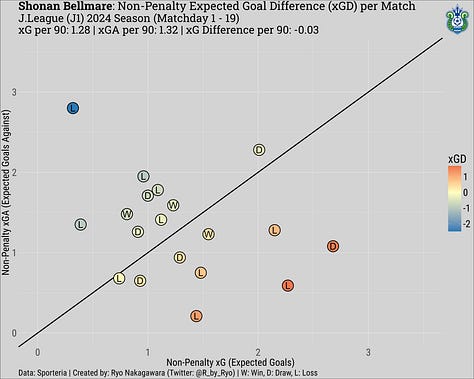
Kyoto Sanga (19th, 14 points): 3 W / 5 D / 11 L
Location // Stadium: Kyoto // Sanga Stadium
Manager: Cho Kwi-jae (South Korea)
15 Goals (20th); 31 Conceded (tied 18th)
Top goal scorer: Yuya Toyokawa (4 goals)
Goalkeeper: Gu S.Y.
Kyoto Sanga are in the relegation fight as usual. After a barn-storming half-season back in J1 for Taichi Hara last season, which was why Kyoto were able to survive quite comfortably, he’s found 2024 to be a lot more challenging. Hara is vastly underperforming in front of goal with only 2 goals from 4.2 xG, although to be fair he’s still doing well in pretty much every other aspect of his game. Instead it’s the wily veteran Yuta Toyokawa leading the team with 4 goals.
You know your attack is misfiring when Shinnosuke Fukuda, from Right Back, has been your best attacking threat. For the record, I do like Fukuda but he should be a complementary piece to a functioning attack instead of being the main guy! Kyoto’s woeful attack is also the result of both of Fuki Yamada and Yudai Kimura leaving on loan to fellow would-be relegation strugglers Tokyo Verdy… I find it shambolic from Kyoto’s management that they have let Verdy gain the fruits of their young talent’s labor instead! As typical of a Cho Kwi-jae team, Kyoto run a lot… and yet for all of the huffing-and-puffing they just don’t seem to be getting much reward for it as Kyoto are 2nd-to-last in both final 3rd and penalty box entries!
A fair excuse for Kyoto’s poor defensive record is that both of their starting Center Backs in Rikito Inoue and Yota Sato were snatched away by Urawa Reds but that still doesn’t excuse the fact that the team has shipped a whopping 35.3% of their goals from set-pieces alone!
While Kyoto are only 3 points away from safetey (albeit Sagan Tosu do have a game in hand…), the yearly relegation battle has fans itching to bin the manager and search for a new direction. At least for now I haven’t heard any news regarding a change but Kyoto will need to dip into the transfer market this summer to really kickstart their efforts to move up the table. Can Kyoto land a Taichi Hara-esque transfer for a second year in a row? We’ll have to wait and see…
All data viz:






Consadole Sapporo (20th, 11 points): 2 W / 5 D / 12 L
Location // Stadium: Sapporo // Sapporo Dome
Manager: Mischa Petrovic (Serbia/Austria)
16 Goals (3rd); 38 Conceded (tied last)
Top goal scorer: Yuya Asano (3 goals)
Goalkeeper: Takanori Sugeno
Consadole Sapporo have been awful. There really isn’t any way to put it nicely. This is Mischa Petrovic’s seventh season in charge of the club and they’ve only gotten worse year-after-year. The signs have been there for the past few seasons, I’ve pointed out these same (defensively, mostly) problems multiple times across many editions of this review newsletter series over the past few years.
Seiya Baba is up there for the worst defender in the J.League, taking over from the hapless Yugo Tatsuta (who now remains rivetted to the bench at Kashiwa Reysol) but truth be told anybody would look awful in this defensive set-up… or lack thereof. Thankfully, in recent matches he’s been played in central midfield, where he should be, to take advantage of his passing range while covering for his lack of defensive ability. Unfortunately, now Ryu Takao is playing there instead who is also extremely mediocre. In prior years, Sapporo could still rely on proper J.League quality players in Takuro Kaneko, Tsuyoshi Ogashiwa, Chanathip, Lucas Fernandes, etc. to get some goals at the other end to make up for their defensive frailities but now they don’t even have that anymore. Yuya Asano (3 goals and 1 assist) and Thai star Supachok (1 goal 4 assists) are both doing their very best (I quite like both personally) but it’s just simply not enough.
There were some positives from their most recent game against Marinos where… they actually looked better defensively and had the right ideas, yet they still conceded around 1 non-penalty xGA and lost 0-1 due to an unlucky handball penalty. Unfortunately, “better performances” aren’t enough at this point as they simply need points, someway and somehow.
All data viz:







Data Visualizations
Squad Age Profiles
I changed the calculation of a squad's median age up a bit by simply taking into account only players that have played 50% of more of total possible league minutes. This is so when looking at the 'average' age of a team, we're doing a better job of considering players who are regulars in the team. I am not sure how other people might do it but from playing around with the raw data it looks OK, most teams have around 9~12 players that meet this threshold so I do think I'm capturing the right selection of players in any given team.
Anyway, here's the list of the U-23 players in the league with the most minutes played so far this season (filtered for those that have played more than 50% of total possible league minutes). You might want to keep an eye on these guys in the short-to-medium term. One of the simplest ways to judge a player’s quality is minutes played. It doesn’t matter how much talent you have or how much potential if, in the end, you don’t actually see minutes on the pitch to show it off!
Time Interval
Ideally I would use a 15 minute interval so I could get rid of that one weird section straddling both halves (40-50th minute) but this was the easiest data set I could get. What's noticeable from this data set is that the good teams generally know how to close out a game and don’t concede many goals in the last 10~20 minutes.
Scoring Situations
Ideally, I would have data that concerns all shots or xG accumulated from different match situations as that would mean a much larger sample of data to power any insights (as goals are only the end result and may not give us information about a team's actual performance).
Team Shot Quantity & Team Shot Quality
In the previous few sections we got to know a lot about the goals that J.League teams scored. However, in a sport like soccer/football goals are hard to come by, they might not really accurately represent a team’s actual ability or performance (even if ultimately, it's the end result that matters). To take things one step further I was able to gather data from Sporteria on shot quantity to dive a bit more into team performances. I’ve reversed the order of some of the stats in these next few plots so that in all cases the top right is best and bottom left is the worst teams when looking at their respective stats.
So, what exactly is expected goals (xG)? Expected goals is a statistic where a model assigns a probability (between 0 and 1) that a shot taken will result in a goal based on a variety of variables and is used for evaluating the quality of chances and predicting players’ and teams’ future performances. A xG model only looks at the variables up to the point that the player touches the ball for a shot. Post-shot xG models covers the information about where in the frame of the goal the shot went (“post” as in all the information after the player touches the ball for the shot) but I won’t cover that here.
For some quick primers on xG check the links below:
The following two sections use xG data from Football-Lab. I’m not privy to all of what goes into their model but the explanation page on their website (in Japanese) tells us about some of the information they used:
Distance from goal?
Angle from goal line?
Aerial duel?
Body part used?
Number of touches? (one touch, more than two touches, set plays, etc.)
Play situation? (Corner kick, direct/indirect free kick, open play, etc.)
So, the usual variables that you might recognize from other xG models are being considered. Combining shot quantity and shot quality numbers gives you a much better idea about a team’s performance on either side of the ball.
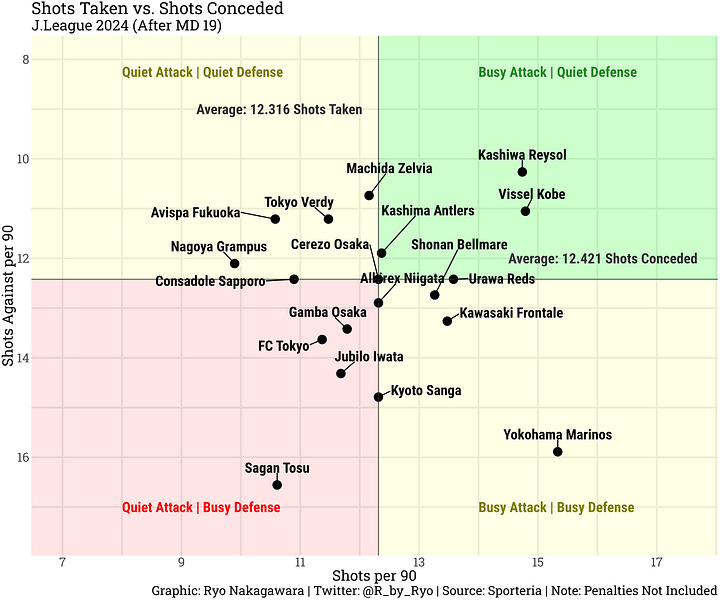



xG Difference
xG Difference is pretty much the same thing as Goal Difference except that we use xG and xGA rather than goals and goals against. This lets us see very quickly which teams generally outperformed their opponents in terms of quality of chances created to quality of chances conceded based on a xG model. This time around I also included the team's results inside the bubble points. So it's easier to see whether a team that had a positive xGD in a specific match couldn't manage to win the game or vice-versa. You ideally want to be below the diagonal line and winning (W) these games as well.
Five Match Rolling Averages
Goals vs. Goals Against
xG vs. xGA
xG vs. Goals
xGA vs. Goals Against
Summary
It’s been a very intriguing J1 2024 season so far with Machida Zelvia surpisingly sustaining their early season form to remain at the top of the table at the half-way point. Quite a few teams are shaking off the cob-webs of a poor 2023 season like Gamba Osaka and Kashima Antlers while others like Shonan Bellmare and Kawasaki Frontale continue to struggle. Also, there are a lot of teams that are simply not going anywhere, up-or-down. It’s always frustrating to see the same mistakes play out matchday after matchday, season review after season review…
On a positive note there have been plenty of surprises and entertainment so far both in terms of players and teams. While this summer we will have to say good bye to quite a few J.League stars… this simply means there will be an opportunity for another player to step up and shine in their place!
Hope you all have enjoyed this new edition of the J.League mid-season review.
Thanks for reading!






